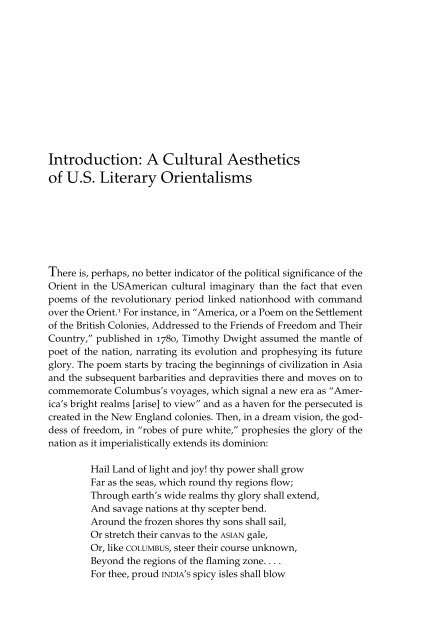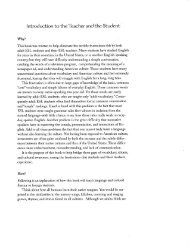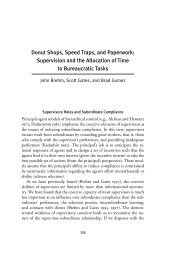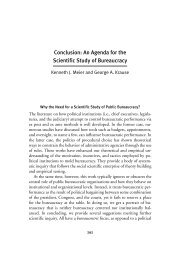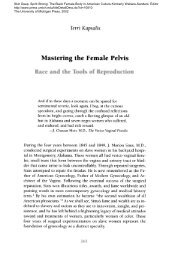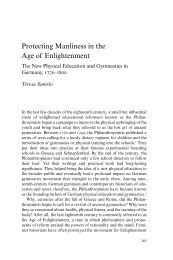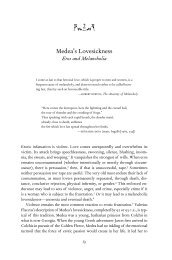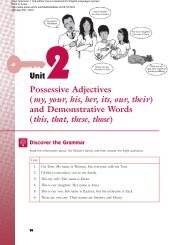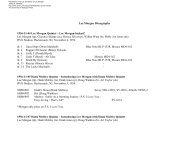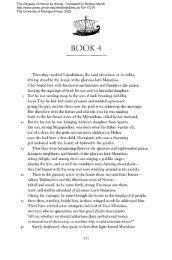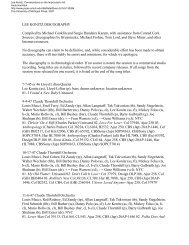Introduction - The University of Michigan Press
Introduction - The University of Michigan Press
Introduction - The University of Michigan Press
You also want an ePaper? Increase the reach of your titles
YUMPU automatically turns print PDFs into web optimized ePapers that Google loves.
<strong>Introduction</strong>: A Cultural Aesthetics<br />
<strong>of</strong> U.S. Literary Orientalisms<br />
<strong>The</strong>re is, perhaps, no better indicator <strong>of</strong> the political significance <strong>of</strong> the<br />
Orient in the USAmerican cultural imaginary than the fact that even<br />
poems <strong>of</strong> the revolutionary period linked nationhood with command<br />
over the Orient. 1 For instance, in “America, or a Poem on the Settlement<br />
<strong>of</strong> the British Colonies, Addressed to the Friends <strong>of</strong> Freedom and <strong>The</strong>ir<br />
Country,” published in 1780, Timothy Dwight assumed the mantle <strong>of</strong><br />
poet <strong>of</strong> the nation, narrating its evolution and prophesying its future<br />
glory. <strong>The</strong> poem starts by tracing the beginnings <strong>of</strong> civilization in Asia<br />
and the subsequent barbarities and depravities there and moves on to<br />
commemorate Columbus’s voyages, which signal a new era as “America’s<br />
bright realms [arise] to view” and as a haven for the persecuted is<br />
created in the New England colonies. <strong>The</strong>n, in a dream vision, the goddess<br />
<strong>of</strong> freedom, in “robes <strong>of</strong> pure white,” prophesies the glory <strong>of</strong> the<br />
nation as it imperialistically extends its dominion:<br />
Hail Land <strong>of</strong> light and joy! thy power shall grow<br />
Far as the seas, which round thy regions flow;<br />
Through earth’s wide realms thy glory shall extend,<br />
And savage nations at thy scepter bend.<br />
Around the frozen shores thy sons shall sail,<br />
Or stretch their canvas to the ASIAN gale,<br />
Or, like COLUMBUS, steer their course unknown,<br />
Beyond the regions <strong>of</strong> the flaming zone. . . .<br />
For thee, proud INDIA’S spicy isles shall blow
2 u.s. orientalisms<br />
Bright silks be wrought, and sparkling diamonds glow;<br />
Earth’s richest realms their treasures shall unfold<br />
And op’ning mountains yield the flaming gold. 2<br />
America marches triumphantly over savage nations, emerging as leader<br />
and bearer <strong>of</strong> civilization. In recognition <strong>of</strong> America’s glory and power,<br />
India pays obeisance to it. What is prefigured in the poem took concrete<br />
shape twenty years later, when Dwight became one <strong>of</strong> the founding<br />
members <strong>of</strong> the American Board <strong>of</strong> Commissioners for Foreign Missions<br />
in 1811. A major agenda <strong>of</strong> this organization was the conversion <strong>of</strong><br />
heathens in the Orient.<br />
A century after the publication <strong>of</strong> Dwight’s poem, an equally patriotic<br />
John Fiske, an eminent philosopher and historian, delivered a series<br />
<strong>of</strong> lectures titled “American Political Ideas, Viewed from the Standpoint<br />
<strong>of</strong> Evolution.” <strong>The</strong> most popular lecture in the series was called “Manifest<br />
Destiny.” In this lecture, Fiske reviewed the future <strong>of</strong> Europe during<br />
the Protestant and Catholic struggles in the sixteenth century in light <strong>of</strong><br />
Columbus’s discoveries and argued that Europe could either progress<br />
or “fall forever into the barren and monotonous way <strong>of</strong> living and thinking<br />
which [had] always distinguished the half-civilized populations <strong>of</strong><br />
Asia.” 3 <strong>The</strong> discovery <strong>of</strong> the Americas, however, ensured that Europe<br />
would not be consigned to Asian lethargy. Here opened up an enormous<br />
region, and it was clear to Fiske that “the race which here should<br />
gain the victory was clearly destined hereafter to take the lead in the<br />
world.” 4 Fiske proclaimed that “In the United States <strong>of</strong> America a century<br />
hence we shall . . . have a political aggregation immeasurably surpassing<br />
in power and dimensions any empire that has as yet existed.” 5<br />
In time, continues Fiske, “it will be possible to speak <strong>of</strong> the UNITED STATES<br />
as stretching from pole to pole.” 6<br />
Dwight’s postrevolutionary poem and Fiske’s lecture, the latter<br />
written just before a period <strong>of</strong> rapid overseas expansion, demonstrate<br />
the remarkable persistence with which ideas <strong>of</strong> empire and the Orient<br />
were linked in the cultural imaginary for over a century. 7 In Dwight’s<br />
poem, the Orient (specifically Asia) is a naturalized trope for the imperial<br />
imaginary because it is simply a part <strong>of</strong> historical progression, a final<br />
realization <strong>of</strong> Columbus’s thwarted attempts. In Fiske’s lecture, control<br />
over the Orient is a supreme signifier <strong>of</strong> imperial power. And for both<br />
Dwight and Fiske, the idea <strong>of</strong> civilization and empire moving west, culminating<br />
in the New World, is a powerful raced one that thrives on distinctions<br />
between EuroAmerican uprightness and Oriental degradation.
introduction 3<br />
Incarnated as the goddess <strong>of</strong> freedom in white robes, America, it is suggested,<br />
has a natural right over Asia. Yet the Asia that Dwight was writing<br />
about had at that time entered the imperial consciousness <strong>of</strong> Europe<br />
as Britain began to exercise control over India, a fact that Dwight, as a<br />
future missionary organizer, would have known well. In envisioning<br />
for the United States a cultural, material, and political dominion over<br />
India, Dwight was asserting the imperial right <strong>of</strong> the new nation over<br />
the Orient, a right that had hitherto been assumed by Europe but that<br />
“naturally” belonged to USAmerica from the time <strong>of</strong> Columbus. In<br />
Fiske’s evolutionary scheme, Asia is associated both with barbarism and<br />
inertia; it is a pernicious contagion to be avoided or, as Fiske suggests<br />
later in his lecture, a passive entity improving through British rule.<br />
Dwight’s and Fiske’s conception <strong>of</strong> Asia as part <strong>of</strong> the imperial<br />
imaginary was repeatedly invoked in literary works. For at least a century,<br />
from the 1790s to the 1890s, poets, dramatists, essayists, novelists,<br />
and short-story writers routinely wrote about different Orients and produced<br />
a series <strong>of</strong> literary works in which the nation was variously<br />
embodied as vigorous, active, masculinized, and morally upright<br />
Columbia-as-empire, against versions <strong>of</strong> a decaying, passive, demasculinized,<br />
deviant, or spiritual Orient. Yet this imperial body was, to use<br />
Judith Butler’s terminology, very much a “figure in crisis,” dependent<br />
on the Oriental qualities it sought to (control and) dissociate itself from. 8<br />
Thus, a naturalized discourse <strong>of</strong> empire, predicated on oppositions, was<br />
interrupted by a violent destabilization <strong>of</strong> these oppositions, usually<br />
revealed in moments when questions <strong>of</strong> national incoherence surfaced.<br />
<strong>The</strong> Orient served the dual purpose <strong>of</strong> containing national schisms and<br />
constructing an imperial nationhood. <strong>The</strong> problematic configuration <strong>of</strong><br />
the imperial body and the mapping <strong>of</strong> raced and gendered oppositions<br />
in USAmerican Oriental works as varied as Royall Tyler’s <strong>The</strong> Algerine<br />
Captive, John DeForest’s Irene the Missionary, Emerson’s “Fate,” and<br />
Whitman’s “Passage to India” is the focus <strong>of</strong> this book. <strong>The</strong>se texts testify<br />
both to the importance <strong>of</strong> Orientalism as a needed, compensatory,<br />
raced rhetoric in the cultural imaginary and to the interest <strong>of</strong> the reading<br />
public in matters relating to the Orient, and they defy the insularity<br />
traditionally ascribed to eighteenth- and nineteenth-century U.S. literature<br />
and culture.<br />
I begin this book with an examination <strong>of</strong> the literature <strong>of</strong> the “Barbary”<br />
Orient generated by the U.S.–North African conflict <strong>of</strong> the late<br />
eighteenth century, including the works <strong>of</strong> writers Royall Tyler, Susanna<br />
Rowson, and Washington Irving. I then move on to the Near Eastern Ori-
4 u.s. orientalisms<br />
entalist literature <strong>of</strong> the nineteenth century in light <strong>of</strong> Egyptology and the<br />
growth <strong>of</strong> missionary fervor, including the works <strong>of</strong> novelists John<br />
DeForest and Maria Susanna Cummins, poet Herman Melville, and<br />
short-story writers Edgar Allan Poe and Harriet Prescott Sp<strong>of</strong>ford.<br />
Finally, I consider the Indic Orientalism <strong>of</strong> the nineteenth century in the<br />
context <strong>of</strong> Indology, British colonialism, and the push for Asian trade in<br />
the United States, focusing particularly on Emerson and Whitman.<br />
As the plural term Orientalisms in the title <strong>of</strong> this book suggests, these<br />
literary texts created multiple and diverse varieties <strong>of</strong> imaginary Orients.<br />
In different ways, writers maintained a dialogue with or strove to create<br />
an indigenous Orientalism premised on the idea <strong>of</strong> civilization and<br />
empire moving west, from Asia, through Europe, to culmination in the<br />
New World. <strong>The</strong> New World thus displaced Britain as empire. <strong>The</strong> Orient<br />
was seen as the new frontier against which the United States—variously<br />
represented as Columbia, Libertad, or Atlas, but always powerful and<br />
whole—could define itself in terms <strong>of</strong> virtue and world mission.<br />
This task <strong>of</strong> imperial self-definition, however, was anxiety-ridden.<br />
<strong>The</strong> rhetoric <strong>of</strong> empire that permeates these works relies on various<br />
raced and gendered distinctions between Oriental despotism, sensuality,<br />
idleness, moral flaccidity, effeminacy, and sexual aberrance, on the<br />
one hand, and USAmerican democracy, rigorous Anglo-American<br />
morality, industry, healthy heteronormativity, and masculinity, on the<br />
other. But these oppositions are deployed to repress or allay fears about<br />
the wholeness and stability <strong>of</strong> the nation in the face <strong>of</strong> diverse ethnic<br />
immigration and African American and Native American presences.<br />
Similarly, the gendered polemic within these works resists the discourse<br />
on empire by questioning both the masculine and the heteronormative<br />
gender constructions <strong>of</strong> the New World.<br />
As noted in the preface, I use the term Orient in this study strategically<br />
both to invoke Edward Said’s polemical definition and to critique<br />
it. In his book Orientalism, Said describes the Orient as a European<br />
invention, “a place <strong>of</strong> romance, exotic beings, haunting memories and<br />
landscapes, remarkable experiences,” and also Europe’s “deepest and<br />
most recurring images <strong>of</strong> the Other.” 9 Thus, Western representations <strong>of</strong><br />
the Orient, no matter where and when this Orient might be located,<br />
include features that are disturbingly similar. Said uses Foucault’s<br />
notion <strong>of</strong> discourse as outlined in <strong>The</strong> Archaeology <strong>of</strong> Knowledge and Discipline<br />
and Punish to describe Orientalism. Orientalism has functioned as<br />
a disciplinary practice “for dealing with the Orient—dealing with it by<br />
making statements about it, authorizing views <strong>of</strong> it, describing it, by
introduction 5<br />
teaching it, settling it, ruling over it: in short, Orientalism as a Western<br />
style for dominating, restructuring, and having authority over the Orient.”<br />
10 Said demonstrates how from the eighteenth century onward,<br />
Oriental representation has always been linked to Western colonialism<br />
and imperialism. More importantly, Said shows the relation between<br />
the Westerner and the Orient/Oriental to be sexual and gendered. <strong>The</strong><br />
Orient, uniformly associated with sexual promise, sensuality, and<br />
unlimited desire, is an “exclusively male province; . . . women are usually<br />
the creatures <strong>of</strong> a male power-fantasy. <strong>The</strong>y express unlimited sensuality,<br />
they are more or less stupid, and above all they are willing.” 11<br />
<strong>The</strong> prototype <strong>of</strong> such images is Flaubert’s Kuchuk Hanem. In the Westerner’s<br />
view, the Orient always invites penetration and insemination. 12<br />
<strong>The</strong> impact <strong>of</strong> Said’s Orientalism on disciplines as diverse as history,<br />
literature, linguistics, and political science cannot be exaggerated. In literary<br />
studies, Orientalism generated enormous critical activity in the<br />
decoding <strong>of</strong> texts heret<strong>of</strong>ore seen as simply symbolic and existential and<br />
revealed them to be texts <strong>of</strong> high imperialism, complicit with empire.<br />
Like many postcolonialists, I too remain indebted to Said’s pioneering<br />
work. I depart from Said’s theoretical formulations, however, in two<br />
crucial respects: in pursuing issues <strong>of</strong> gender from a feminist and nonheterosexual<br />
imperative, and in emphasizing the discrete, rather than<br />
simply the unchanging, nature <strong>of</strong> Orientalist discourses within the<br />
United States. 13<br />
In critiquing the persistence <strong>of</strong> Western characterizations <strong>of</strong> the<br />
Orient as passive, supine, available woman/body, Said obviously<br />
draws attention to the power relations inherent in constructions <strong>of</strong> the<br />
Orient. This configuration, however, problematically assumes desire to<br />
be a male prerogative alone and situates masculinity as always powerful<br />
and separate from that (Woman) which it seeks to control; it also<br />
assumes a heterosexist model for gender relations. My study <strong>of</strong> U.S.<br />
Orientalisms challenges all these presumptions. First, the very contribution<br />
<strong>of</strong> women writers such as Susanna Rowson, Maria Susanna<br />
Cummins, and Harriet Prescott Sp<strong>of</strong>ford—belies the idea <strong>of</strong> Orientalism<br />
as a male domain. <strong>The</strong>se women continually critique the patriarchal<br />
impulses <strong>of</strong> imperialism and explore the consequences <strong>of</strong> racial<br />
blurring, even as their transgressive positionings are partially<br />
reclaimed by the dominant imperial impetus <strong>of</strong> the discourses <strong>of</strong> Orientalism.<br />
Many U.S. Orientalist works also break down the traditional<br />
gendered dichotomies <strong>of</strong> mind and body that Said invokes. In the writings<br />
<strong>of</strong> Indic Orientalists, for instance, the muscular, athletic, imperial
6 u.s. orientalisms<br />
body <strong>of</strong> the nation depends on an evocation <strong>of</strong> India as a dematerialized<br />
and disembodied spirit or soul; the investment in materiality and<br />
body is USAmerican, while the association with spirit is Oriental. Second,<br />
as my analyses demonstrate, the autonomy and wholeness <strong>of</strong> the<br />
imperial body is highly fragile, dependent on the raced/gendered<br />
Other that it presumes to control. Here, I am guided by Judith Butler’s<br />
attempts to resituate femininity out <strong>of</strong> the paradigm <strong>of</strong> dominated/othered<br />
and by Homi K. Bhabha’s theorizations on the stereotype as an<br />
“ambivalent, contradictory mode <strong>of</strong> representation,” based as much on<br />
anxiety as on assertion, the enunciation <strong>of</strong> a split subject. 14 Third, many<br />
U.S. Orientalist texts challenge heterosexist presumptions because the<br />
Oriental encounter opens up possibilities <strong>of</strong> homoerotic gendering that<br />
cannot be freely articulated at home. 15<br />
My second major departure from Said is from the idea <strong>of</strong> Orientalism<br />
as an unchanging discourse. Most obviously, the construction <strong>of</strong> the<br />
Orient changes according to different contexts, and Said himself<br />
acknowledges that his focus is largely on the Muslim Near and Middle<br />
East. As my study demonstrates, the parodic U.S. Orientalism <strong>of</strong> the<br />
Near East, as exemplified in the works <strong>of</strong> such writers as DeForest and<br />
Cummins in the mid-nineteenth century, is very different from Emerson’s<br />
reverent Indological Orientalism during the same period. Similarly,<br />
the nationalistic fervor generated by the capture and enslavement<br />
<strong>of</strong> U.S. sailors in Algiers enters the representation <strong>of</strong> the Orient in the<br />
drama and novels set in Algiers in a different manner than does Egyptomania<br />
and missionary activity in the Near Eastern Orientalist literature<br />
a generation later.<br />
In departing from Said in these two crucial areas, however, I do<br />
not simply embrace ambivalence and hybridity apolitically and ahistorically,<br />
as universally applicable. 16 <strong>The</strong> major contribution <strong>of</strong> Said’s<br />
Orientalism was to make it impossible to think about Western constructions<br />
<strong>of</strong> the Orient in purely spiritual, philosophical, or symbolic terms<br />
and, by analogy, to make it problematic to deal with any construction<br />
<strong>of</strong> an Other without thinking about relations <strong>of</strong> power. To simply<br />
ignore such relations and questions <strong>of</strong> hegemony is, as Ella Shohat has<br />
suggested, to “sanctify the fait accompli <strong>of</strong> colonial violence.” 17 I thus<br />
use the term Orientalism throughout this study to call attention to the<br />
historicity <strong>of</strong> U.S. literary writings about various Orients and their participation<br />
in raced discourses <strong>of</strong> empire in the nineteenth century, not<br />
to suggest an unchanging, seamless, repetitive tradition. <strong>The</strong> three different<br />
Oriental sites explored in this study—Algerian, Egyptological,
introduction 7<br />
and Indic—generate a wide variety <strong>of</strong> concerns within the omnivorous<br />
framework <strong>of</strong> imperial ideology; examining them together, however,<br />
points to the sheer magnitude <strong>of</strong> U.S. literary Orientalisms for a century<br />
prior to the 1890s.<br />
My use <strong>of</strong> Said’s and Foucault’s terms in the plural forms Orientalisms<br />
and discourses also indicates my need to open up these terms to<br />
the possibility both <strong>of</strong> different kinds <strong>of</strong> literary Orientalisms and <strong>of</strong> different<br />
kinds <strong>of</strong> discourses on the Orient. For example, although Poe and<br />
DeForest both critique the idea <strong>of</strong> mastering the Orient through Egyptology,<br />
Poe’s stories demonstrate the destructive consequences <strong>of</strong> this<br />
mastery tragically, while DeForest’s novel does so comically. Similarly,<br />
although many appeals for increasing trade with Asia were made on the<br />
grounds <strong>of</strong> national power, missionary appeals made on similar<br />
grounds were far more concerned with representing the wretchedness<br />
<strong>of</strong> Asia than were political diatribes.<br />
Because the idea <strong>of</strong> discourse has so <strong>of</strong>ten been linked with disciplinary<br />
practice and repression alone, it is important to clarify Foucault’s<br />
use <strong>of</strong> the term discourse, its relationship to this book, and the<br />
departure <strong>of</strong> this book from some <strong>of</strong> Foucault’s formulations. In <strong>The</strong><br />
Archaeology <strong>of</strong> Knowledge, Foucault explains the idea <strong>of</strong> discursive formation.<br />
Any type <strong>of</strong> statements, irrespective <strong>of</strong> the conventional fields<br />
they belong to or the time period when they were written, form a field<br />
<strong>of</strong> discourse if they refer to the same object. 18 Unlike conventional history,<br />
however, which unfolds as an oeuvre <strong>of</strong> collective statements or<br />
philosophy where statements are reconstituted as chains <strong>of</strong> inference, a<br />
discursive formation is linked together by systems <strong>of</strong> dispersion. 19 My<br />
pluralization <strong>of</strong> discourse emphasizes the differences that Foucault himself<br />
recognizes within a field <strong>of</strong> discourse. Throughout his career, Foucault<br />
remained aware <strong>of</strong> the ubiquity <strong>of</strong> the technologies <strong>of</strong> power<br />
through which laws, cultural values, and sexual practices were generated.<br />
His effort in Discipline and Punish was to present a “genealogy <strong>of</strong><br />
the present scientifico-legal complex from which the power to punish<br />
derives its bases.” 20 In an interview in 1982, Foucault described his role<br />
as one <strong>of</strong> showing people “that they are much freer than they feel, that<br />
people accept as truth, as evidence, some themes which have been built<br />
up at a certain moment during history, and that this so-called evidence<br />
can be criticized and destroyed.” 21 Resistance, in other words, can come<br />
from the act <strong>of</strong> strategically historicizing discursive formations, a strategy<br />
I use in examining literary discourses on the Orient.<br />
Despite Foucault’s own massive studies <strong>of</strong> the juridical system and
8 u.s. orientalisms<br />
<strong>of</strong> the discourses on sexuality, however, his notoriously complex and<br />
<strong>of</strong>ten contradictory statements on power, knowledge, and resistance<br />
have led to a Foucauldian practice, particularly within U.S. literary<br />
studies, that all but denies any significance to specifics <strong>of</strong> power. In the<br />
first volume <strong>of</strong> his History <strong>of</strong> Sexuality, for instance, Foucault writes,<br />
“Where there is power, there is resistance, and yet . . . this resistance is<br />
never in a position <strong>of</strong> exteriority in relation to power. Should it be said<br />
that one is always ‘inside’ power, there is no ‘escaping’ it . . . ? This<br />
would be to misunderstand the strictly relational character <strong>of</strong> power<br />
relationships. <strong>The</strong>ir existence depends on a multiplicity <strong>of</strong> points <strong>of</strong><br />
resistance.” 22 Foucault comes so close to collapsing notions <strong>of</strong> power<br />
and resistance here that it is no wonder that many Foucault-inspired<br />
new historicists, Foucault’s denial <strong>of</strong> the inclusiveness <strong>of</strong> power<br />
notwithstanding, minimize the significance <strong>of</strong> power relations. 23 Many<br />
people, taking the idea <strong>of</strong> circulation and localization <strong>of</strong> power to mean<br />
a scrutiny <strong>of</strong> the local power alone, have ended up denying the relevance<br />
<strong>of</strong> such issues as colonialism and imperialism. <strong>The</strong> result, as<br />
Jonathan Arac and Harriet Ritvo have suggested, is that much <strong>of</strong> this<br />
work, “however fine its local analysis, comes to little conclusion except<br />
that any significant cultural practice is complicit in the power it might<br />
think to be opposing.” 24<br />
My own analyses benefit from Foucault’s notion <strong>of</strong> discursive formations<br />
in that I see U.S. literary Orientalist texts as inextricably related<br />
to discourses on the Orient. I pay particular attention, however, to the<br />
deformative power <strong>of</strong> both particular writers and contexts. Throughout<br />
this study, I note the numerous ways in which writers enunciate resistances<br />
to the mechanisms <strong>of</strong> power that seem inevitable in discourses on<br />
the Orient. But I do not suggest that these enunciations were simply<br />
complicit with furthering an imperial will or a stereotypical Orient.<br />
Instead, I focus on the specific nature <strong>of</strong> the challenges against the systemic<br />
discourses on the Orient.<br />
I use nation and empire as related terms in this study because <strong>of</strong><br />
the frequency with which the nation was constructed as an empire in<br />
Orientalist works. <strong>The</strong> close connection between ideas <strong>of</strong> nation and<br />
those <strong>of</strong> empire has also been noted by theorists <strong>of</strong> nationalism. Timothy<br />
Brennan has pointed out how European nationalism was motivated<br />
by European colonial activity: “<strong>The</strong> ‘national idea,’ in other<br />
words, flourished in the soil <strong>of</strong> foreign conquest.” 25 Both Benedict<br />
Anderson and George L. Mosse also situate the beginnings <strong>of</strong> modern<br />
European nationalism in the late eighteenth century, a period coex-
introduction 9<br />
tensive with the beginnings <strong>of</strong> colonialism. 26 It would be a mistake,<br />
however, to think <strong>of</strong> nationalism and imperialism as identical. Even<br />
though the founding fathers <strong>of</strong>ten thought <strong>of</strong> the United States as an<br />
empire, the very nature <strong>of</strong> the connection between nation and empire<br />
necessarily changed with different historical and social contexts.<br />
Nation and empire are relational and related terms, one dependent on<br />
the other.<br />
Here we come to a crucial difference between U.S. and European<br />
Orientalisms. Colonialism, with its ensuing violent contact with non-<br />
European others, ensured that for European countries, particularly England<br />
and France, the narrative <strong>of</strong> empire as unquestioned was inherently<br />
unstable and needed to be supported by ideas <strong>of</strong> firm national<br />
character. In the United States, however, imperialism, particularly with<br />
respect to the Orient, could be constructed much more benevolently, as<br />
teleology. Since the “discovery” <strong>of</strong> the Americas by Columbus was popularly<br />
transmitted as the outcome <strong>of</strong> a vision to reach the Orient, contemporary<br />
arguments about seizing Oriental trade or civilizing Orientals<br />
through missionary activity were accompanied by visionary<br />
statements about completing Columbus’s original mission. Tropes <strong>of</strong><br />
expansion and control over various specific Orients were thus mystified<br />
as “natural” through the complex genealogy <strong>of</strong> the country’s intimate<br />
associations with the search for the Orient.<br />
In addition, in contrast to the situation in Europe, the idea <strong>of</strong> nation<br />
in the United States, predicated as it was on the internal colonization <strong>of</strong><br />
Native Americans and African Americans, was rife with instabilities. As<br />
Toni Morrison has suggested, values that are touted as prototypically<br />
“American” and that <strong>of</strong>ten form the focus <strong>of</strong> white U.S. literature are<br />
shaped in response to an Africanist presence that had to be either<br />
repressed morally and politically or constructed as an absolute Other<br />
(primitive, savage), against which a quintessential (white) national<br />
identity could be articulated. 27 Morrison’s argument compellingly<br />
places slavery (as “blackness”) and racial alterity at the center <strong>of</strong> the<br />
construction <strong>of</strong> national identity. 28 Unlike the idea <strong>of</strong> nation, however,<br />
the idea <strong>of</strong> a U.S. empire, seen as much more benign than the idea <strong>of</strong><br />
empire in European Orientalist works, was used to both mystify<br />
national instabilities and bolster the idea <strong>of</strong> a strong, expanding nation.<br />
It was thus no accident that the most popular figure for the nation in<br />
U.S. Orientalist works was Columbia, the feminization <strong>of</strong> Columbus.<br />
Yet, because <strong>of</strong> this attempted mystification, U.S. literary Orientalism<br />
became the site <strong>of</strong> a triadic encounter in which the Africanist and Native
10 u.s. orientalisms<br />
American presences returned to haunt and question the cultural and<br />
political hegemony <strong>of</strong> the New World.<br />
Of course, the Orient here is not simply a displaced site <strong>of</strong> national<br />
racial issues. <strong>The</strong> encounter with the Orient works powerfully to articulate<br />
and shape national identity in terms <strong>of</strong> a youthful nation revitalizing<br />
the world with messages <strong>of</strong> liberty and virtue or in terms <strong>of</strong> a radical<br />
historical shift through which the United States becomes the newest<br />
seat <strong>of</strong> empire to which the Orient needs to turn. Of all the discourses on<br />
the Orient—political, economic, scientific—literary Orientalism most<br />
significantly challenges, even as it evokes, imperialist constructions <strong>of</strong><br />
national identity and <strong>of</strong> the Orient, as well as the racial hierarchies at<br />
home. In fields like phrenology and archaeology, Egyptomania and<br />
interest in the Near Eastern Orient produced massive phrenological<br />
studies supporting Caucasian superiority (such as Morton’s Crania<br />
Ægyptica). Yet Poe, during the same time, engaged in compelling critiques<br />
<strong>of</strong> Western imperial will in such stories as “Ligeia” and “A Tale <strong>of</strong><br />
the Ragged Mountains.” Similarly, such novelists as John DeForest and<br />
Maria Susanna Cummins both ridiculed and deployed the pretentious<br />
figure <strong>of</strong> the archaeologist venturing east.<br />
It should also not surprise us that these literary Orientalist works<br />
were heavily preoccupied with issues <strong>of</strong> gender and sexuality. Ideas <strong>of</strong><br />
empire and nation in the nineteenth century, as in the present, were<br />
raced, and racial distinctions <strong>of</strong>ten depended on gendered distinctions.<br />
For theorists <strong>of</strong> nationalism, nation and gender are <strong>of</strong>ten intimately<br />
related. Benedict Anderson’s connection between nation and gender is<br />
perhaps unwitting. Anderson states, “in the modern world everyone<br />
can, should, and will ‘have’ a nationality, as he or she ‘has’ a gender.” 29<br />
Although Anderson assumes that gender is an unproblematic category,<br />
something that everyone has, rather than a category that is constructed,<br />
his formulation also points to the hegemonic ways in which nation is<br />
gendered. George L. Mosse focuses on this latter aspect in the concept <strong>of</strong><br />
nation. <strong>The</strong> beginnings <strong>of</strong> modern nationalism in the late eighteenth<br />
century coincided with the Protestant revivals in Germany and Britain,<br />
leading to an alliance between nationalism and respectability, “an<br />
alliance that regarded control over sexuality as vital to the concept <strong>of</strong><br />
respectability.” 30 Deviance, aberrance, and excess were unnational,<br />
while respectability, normativity, and control were national. 31 Nationalism<br />
was increasingly associated with an ideal <strong>of</strong> asensual heterosexual<br />
manliness, and even though female national symbols were invoked,<br />
these were essentially static rather than dynamic. 32
introduction 11<br />
Mosse’s analyses are particularly relevant in considering formulations<br />
<strong>of</strong> nation in the United States. <strong>The</strong> curbing <strong>of</strong> overt sensuality and<br />
<strong>of</strong> promiscuous behaviors that would encourage it was particularly<br />
strong in New England, where immigrant purity was routinely contrasted<br />
with European libertine excess. But although Mosse’s arguments<br />
compellingly demonstrate the alliances between nationalism and sexual<br />
codes and between nationalism and heteronormativity, they are based<br />
on the assumption <strong>of</strong> literal, oppositional gender constructions (albeit<br />
highly politicized ones), the hierarchies <strong>of</strong> which are dramatic indications<br />
<strong>of</strong> hegemonic, nationalistic power structures. When national icons,<br />
as bearers <strong>of</strong> national ideology, are invoked in the context <strong>of</strong> empire,<br />
however, gender <strong>of</strong>ten does not work literally.<br />
Here, Rey Chow’s analysis <strong>of</strong> the journalistic representations <strong>of</strong> the<br />
use <strong>of</strong> Lady Liberty in the Tiannanmen Square revolt <strong>of</strong> 1991 is particularly<br />
useful. Chow begins by demonstrating the problems inherent in<br />
seeing gender literally and as an unchanging category. A feminist<br />
friend asks Chow, “How should we read what is going on in China in<br />
terms <strong>of</strong> gender?” Chow responds: “<strong>The</strong> problem is not how we should<br />
read what is going on in China in terms <strong>of</strong> gender, but rather: what do<br />
the events in China tell us about gender as a category, especially as it<br />
relates to the so-called Third World?” 33 By reversing the question,<br />
Chow demonstrates the mutability <strong>of</strong> gender categories in a transnational<br />
context. Chow suggests that even though Lady Liberty is ostensibly<br />
“female,” in the Tiannanmen Square context “woman is not the<br />
heterosexual opposite <strong>of</strong> man, but the symbol <strong>of</strong> what China is<br />
not/does not have.” 34<br />
Chow’s arguments are especially relevant in thinking about U.S.<br />
nationalism in the context <strong>of</strong> Orientalism. Symbols <strong>of</strong> nationhood<br />
evolved and changed from early European conceptions <strong>of</strong> the Americas,<br />
to early settlements in the seventeenth century, and through the revolutionary<br />
period. Europeans pictured the Americas through the body <strong>of</strong><br />
the Native American woman, resplendent with fruits, a symbol <strong>of</strong> fertility.<br />
35 By the seventeenth century, the idea <strong>of</strong> associating the nation with<br />
tropes <strong>of</strong> exploration and conquest coalesced in the figure <strong>of</strong> Columbia,<br />
the feminization <strong>of</strong> Columbus. In Magnalia Christi Americana, Cotton<br />
Mather declared that the New World be called Columbia. It was in the<br />
revolutionary period, however, that Columbia as a symbol for the<br />
United States gained accepted currency. Philip Freneau referred to the<br />
United States as both Columbia and New Albion. 36 Undoubtedly, that<br />
the music <strong>of</strong> “Hail Columbia” was part <strong>of</strong> Washington’s inaugural
12 u.s. orientalisms<br />
march made the symbology more popular. 37 Simultaneously, the eagle,<br />
the symbol <strong>of</strong> the Roman Empire, was adopted as the seal <strong>of</strong> the United<br />
States in 1782. <strong>The</strong> spread eagle, bearing a shield on its breast, an olive<br />
branch in one talon, and thirteen arrows indicating readiness for war in<br />
the other, was <strong>of</strong>ten gendered as male. 38 Yet another revolutionary manifestation<br />
<strong>of</strong> nation was Liberty, deriving immediately from the liberty<br />
cap carried by Britannia on a spear and the Roman goddess <strong>of</strong> liberty. 39<br />
For most Orientalist writers, the idea <strong>of</strong> nation as Columbia was<br />
appealing, no doubt because <strong>of</strong> the trope <strong>of</strong> exploration and empire<br />
inherent in the invocation <strong>of</strong> Columbus’s ventures and his vision <strong>of</strong><br />
reaching the Orient. Columbus’s original dream was idealized and<br />
invoked to naturalize ideas <strong>of</strong> empire. Although strictly in terms <strong>of</strong> a<br />
sex-gender equation Columbia as an early iconic figure for the nation<br />
was female, the Columbia invoked as a justification for expansionism<br />
and control in the context <strong>of</strong> the Orient was gendered differently.<br />
Columbia as a figure for nation as empire was not associated with such<br />
qualities as fluidity, disorder, and emotion, which have, within theories<br />
<strong>of</strong> gender dichotomies, been traditionally associated with femininity;<br />
rather, this Columbia was associated with activity, power, athletic<br />
vigor, and (virtuous) desire for expansion and control, qualities traditionally<br />
coded as male.<br />
In U.S. Orientalist texts, the nation as empire is <strong>of</strong>ten embodied as<br />
young, vigorous, powerful, and masculinized. But the portrayal <strong>of</strong> this<br />
figure is also interrupted by anxious moments in which its imperial gender<br />
construction is destabilized through its encounter with the Oriental<br />
other. For example, in El Fureidis, Maria Susanna Cummins’s hero,<br />
Meredith, loses his sense <strong>of</strong> masculinity and wholeness when confronted<br />
with an image <strong>of</strong> two amorous women. Thus, these Orientalist texts do<br />
not simply perpetuate a repressive patriarchy. 40 Many women writers, in<br />
fact, used the Orient as a site for questioning and undermining the<br />
socially acceptable ideologies <strong>of</strong> womanhood in the late eighteenth and<br />
nineteenth centuries. In Slaves in Algiers, for instance, Susanna Rowson<br />
constructs the harem as a social space for the bonding <strong>of</strong> women, out <strong>of</strong><br />
which emerges a critique <strong>of</strong> the ideal <strong>of</strong> woman as republican mother.<br />
Opened up at key moments in such texts as Cummins’s El Fureidis and<br />
Rowson’s Slaves in Algiers are possibilities <strong>of</strong> queer gendering that<br />
undermine the heteronormativity and patriarchy on which imperial discourse<br />
rests. As this study suggests, an unstable gendered discourse<br />
<strong>of</strong>ten works to contest the ideology <strong>of</strong> superior USAmerican virtue on<br />
which the rhetoric <strong>of</strong> empire within Orientalism depends.
introduction 13<br />
Chapter 1 <strong>of</strong> this study describes the numerous discourses on the<br />
Orient beginning in the postrevolutionary period. Briefly examining the<br />
many commercial, political, and literary contacts with the Orient in the<br />
late eighteenth and nineteenth centuries, it emphasizes the raced and<br />
imperial nature <strong>of</strong> these contacts and puts under question the model <strong>of</strong><br />
New England cultural insularity that has dominated most intellectual<br />
histories <strong>of</strong> the period. Oriental travel writing, in particular, enjoyed a<br />
success that belies such claims. <strong>The</strong> chapter then moves on to examine<br />
the complex interrelationship between the technologies <strong>of</strong> race and the<br />
discourses on the Orient, by examining two important types <strong>of</strong> orientalist<br />
discourses: phrenology and missionary statements.<br />
Egyptology in the United States generated anxieties about racial<br />
hierarchies as much as it did an enthusiasm about decoding the mysteries<br />
<strong>of</strong> the Orient. One can see such anxiety and enthusiasm in Morton’s<br />
Crania Americana (1839) and Crania AEgyptica (1844) and in the ethnographic<br />
writings <strong>of</strong> George S. Gliddon, U.S. consul at Cairo. Both writers<br />
study Egyptian writings to support polygenesis. Official reports on<br />
missionary activity also form an important part <strong>of</strong> Orientalist discourses.<br />
<strong>The</strong> American Board <strong>of</strong> Commissioners for Foreign Missions<br />
was formed in 1811. <strong>The</strong> reports <strong>of</strong> that board <strong>of</strong>fer a fascinating account<br />
<strong>of</strong> the political and racial concerns <strong>of</strong> the missionaries and <strong>of</strong> their need<br />
to be seen as agents <strong>of</strong> a major power. <strong>The</strong> reaction <strong>of</strong> missionaries to the<br />
Oriental churches <strong>of</strong> the Near East suggests a less than certain ethnocentrism.<br />
<strong>The</strong> alarm <strong>of</strong> U.S. missionaries at the laxity <strong>of</strong> Oriental<br />
churches and the daily proximity <strong>of</strong> Christians and Muslims in the Near<br />
East underscores an anxiety about cross-cultural and interracial contact<br />
that reflects fear <strong>of</strong> contamination both from people <strong>of</strong> color within the<br />
country and from imperial contacts abroad.<br />
In Chapter 2, I examine a number <strong>of</strong> literary Orientalist texts <strong>of</strong> the<br />
late eighteenth century that were written in the wake <strong>of</strong> the U.S.–North<br />
African altercation. <strong>The</strong> capture and enslavement <strong>of</strong> U.S. sailors by the<br />
Algerians created an outrage that went unappeased until 1805, when<br />
William Eaton, U.S. consul at Tripoli, coordinated an attack on Derna<br />
and raised the U.S. flag on the city walls. <strong>The</strong> historical occasion thus<br />
provided ready materials for dramatizing oppositions between North<br />
African despotism and immorality, on the one hand, and U.S. freedom<br />
and virtue, on the other. Royall Tyler’s <strong>The</strong> Algerine Captive (1797),<br />
David Everett’s Slaves in Barbary (1797), Susanna Rowson’s Slaves in<br />
Algiers (1794), James Ellison’s <strong>The</strong> American Captive (1812), Jonathan<br />
Smith’s <strong>The</strong> Siege <strong>of</strong> Algiers (1823), and Peter Markoe’s <strong>The</strong> Algerine Spy in
14 u.s. orientalisms<br />
Pennsylvania (1787) all participate in the <strong>of</strong>ficial narrative <strong>of</strong> the United<br />
States as a virtuous empire spreading the light <strong>of</strong> freedom in a dissipated<br />
Orient, the imperial body being constructed through an exclusion <strong>of</strong> both<br />
slavery and deviant Oriental sexuality. But the raced and gendered anxieties<br />
accompanying the construction <strong>of</strong> strong, imperial nationhood are<br />
also evident. Slavery surfaces at the center <strong>of</strong> national consciousness,<br />
splitting the coherence and identity <strong>of</strong> the nation. And all too <strong>of</strong>ten the<br />
gendering and respectability <strong>of</strong> the hero embodying the nation is undermined<br />
by a willing participation in sensual excess, as a discourse <strong>of</strong> sexuality<br />
contends with a discourse <strong>of</strong> empire. For instance, in <strong>The</strong> Algerine<br />
Captive, Tyler’s narrator is made to literally participate in the purchase <strong>of</strong><br />
human cargo. Later, inside a Muslim enclave, he delights in the “feminization”<br />
<strong>of</strong> his body through ritual scrubbing and oiling.<br />
Chapter 3 focuses on the Near Eastern Orientalist literature <strong>of</strong> the<br />
nineteenth century in relation to the Orientalist discourses <strong>of</strong> Egyptology<br />
and missionary Protestantism. While Egyptology generated a rush<br />
<strong>of</strong> self-styled archaeologists chauvinistically ready to excavate all <strong>of</strong> the<br />
Near East, missionaries prompted concerns about the mixture <strong>of</strong> races<br />
and cultures there. In literary Orientalist works about the Near East, the<br />
border becomes a site <strong>of</strong> anxiety and transgression. Most works appropriate<br />
the hierarchical paradigm <strong>of</strong> white explorer and explored Oriental,<br />
but they do this so self-consciously and critically that what emerges<br />
is a parodic Orientalism in contestation with the dominant discourses<br />
on the Orient, the latter being recuperated only as points <strong>of</strong> closure. In<br />
John DeForest’s Irene the Missionary (1879), for instance, the vigorous,<br />
USAmerican male archaeologist is constantly critiqued in his quest to<br />
excavate all <strong>of</strong> the Near East. <strong>The</strong>se works also reveal the precariousness<br />
<strong>of</strong> the racial alterity on which the missionary-imperial body is constructed,<br />
by introducing moments when this body is transformed<br />
through interracial contact. In William Ware’s Zenobia (1837), for<br />
instance, Lucius M. Piso fears for his manly body in the Oriental languor<br />
<strong>of</strong> Palmyra. Maria Susanna Cummins, however, uses racial intermixing<br />
to both contain and subvert imperial race and gender hierarchies.<br />
Exploiting the new possibilities available to women as a result <strong>of</strong> missionary<br />
work overseas, Cummins, in El Fureidis (1860), creates Havilah,<br />
a woman pure but not bound by domesticity, pious but overly learned,<br />
beautiful but more athletic than her male archaeologist suitor. Through<br />
this racially mixed character, Cummins challenges the patriarchy within<br />
imperialism while still maintaining the raced imperatives <strong>of</strong> the latter.<br />
Finally, chapter 3 explores the tension between the raced and gendered
introduction 15<br />
formations <strong>of</strong> Near Eastern orientalism by examining the interventions<br />
<strong>of</strong> African American David S. Dorr. In A Colored Man Round the World<br />
(1858), Dorr negotiates his critique <strong>of</strong> white Egyptology and his willed<br />
identification with patriarchal imperial structures that create a space for<br />
his contingently “free” body, to reveal the omnivorous attraction <strong>of</strong> Orientalist<br />
narratives <strong>of</strong> empire.<br />
Chapter 4 examines three <strong>of</strong> the most subversive Near Eastern orientalist<br />
writers: Edgar Allan Poe, Harriet Prescott Sp<strong>of</strong>ford, and Herman<br />
Melville. <strong>The</strong>se writers critique imperial-hermeneutic power through a<br />
raced and gendered destabilization <strong>of</strong> the body <strong>of</strong> the archaeologist/<br />
traveler/hermeneute. <strong>The</strong> comic critique <strong>of</strong> Orientalist power gives way<br />
here to a demonstration <strong>of</strong> its tragic consequences. Poe critiques both the<br />
repressive discourses on the Orient and the suppression <strong>of</strong> the facts <strong>of</strong><br />
Western colonialism in the U.S. imaginary. “Ligeia,” the most complex <strong>of</strong><br />
Poe’s oriental tales, demonstrates the crisis <strong>of</strong> identity consequent on the<br />
inability <strong>of</strong> the narrator to support either an imperialist national identity<br />
or Southern nationalism. <strong>The</strong> character Ligeia, suggestive <strong>of</strong> an Oriental<br />
and Africanist presence, undermines through her power the narrator’s<br />
attempts at coherent raced and gendered self-fashioning. In “Desert<br />
Sands” (1863), Sp<strong>of</strong>ford critiques the objectification <strong>of</strong> the Other inherent<br />
in the aesthetics <strong>of</strong> Oriental authentication. By literally equating the artistic<br />
triumph <strong>of</strong> the hero (a triumph won by a mastery over the Oriental<br />
landscape) with the death <strong>of</strong> the woman, Sp<strong>of</strong>ford exposes the repressive<br />
patriarchal basis <strong>of</strong> Western imperialism. Writing contemporaneously<br />
with Sp<strong>of</strong>ford, Melville, in Clarel, problematizes the idea <strong>of</strong> USAmerican<br />
hermeneutic power by dramatizing the resistance <strong>of</strong> the Oriental subject<br />
to appropriation and control. Through Clarel, a young theology student<br />
journeying the Near East, Melville eroticizes the relationship between<br />
the New World and the Orient and demonstrates how the racial-cultural<br />
difference <strong>of</strong> the Orient cannot be contained by a creation <strong>of</strong> race hierarchies<br />
or through phallocentric othering. Instead, Clarel questions the<br />
oppositions between the New World and the Near East through the circulation<br />
<strong>of</strong> homoerotic desire.<br />
Chapter 5 focuses on popular Indian Orientalist writers, the complex<br />
cultural discourses on Indology, the push for Asian markets, theories<br />
about the westerly movement <strong>of</strong> empire from its inception in Asia,<br />
and the colonization <strong>of</strong> India. It then examines Indic Orientalist writings,<br />
including works by such poets as William Rounseville Alger and<br />
James Russell Lowell, which contrast a youthful USAmerica with a<br />
spent and dissipated Orient. <strong>The</strong> enormously successful Bayard Taylor,
16 u.s. orientalisms<br />
<strong>of</strong>ten dismissed as sentimental and romantic, exhibits in his travel writings<br />
a keen historical awareness and a self-consciousness about constructing<br />
the Orient that opens possibilities for a transgressive Indic orientalism.<br />
In chapters 6 and 7, I specifically analyze the Indic Orientalist texts<br />
<strong>of</strong> Emerson and Whitman in the context <strong>of</strong> the political, economic, and<br />
philosophical discourses on India sketched in chapter 5. In chapter 6,<br />
through an examination <strong>of</strong> Emerson’s “Indian Superstition,” “Plato,”<br />
English Traits, and “Fate,” I show how Emerson’s raced construction <strong>of</strong><br />
India as a passive and spiritual Other against an active and material<br />
New World is an anxious attempt to recuperate the nation as vibrant<br />
and whole. As Emerson became more involved with issues <strong>of</strong> slavery<br />
and race, he increasingly sought to exclude the social-material Asia and<br />
its raced bodies (and create a transhistorical Asia, free <strong>of</strong> divisive racial<br />
politics) to facilitate the construction <strong>of</strong> the nation as a strong, whole,<br />
athletic body. Yet race powerfully surfaces in Emerson’s essays through<br />
his engagement with theories <strong>of</strong> racial evolution and Anglo-Saxon destiny.<br />
And at significant moments in Emerson’s construction <strong>of</strong> the Indic<br />
Orient, the normativity and wholeness <strong>of</strong> the nation is questioned as it<br />
becomes evident that the idea <strong>of</strong> a powerful (male) nationhood depends<br />
greatly on a homoerotic nationhood that needs to be suppressed.<br />
Chapter 7 examines several <strong>of</strong> Whitman’s Orientalist poems,<br />
including “Salut Au Monde,” “Facing West from California’s Shores,”<br />
and “Passage to India,” and traces their construction <strong>of</strong> India as a maternal<br />
trope and a raced Other lacking its own agency. I suggest that in<br />
these poems, particularly in “Passage to India,” the fantasy <strong>of</strong> cross-continental<br />
unification does not simply exist in a spiritual imaginary where<br />
power relations are suspended. “Passage to India,” for instance, historicizes<br />
India but does so strategically, excluding the realities <strong>of</strong> British<br />
colonialism. This excluded history contours the embodiment <strong>of</strong> the<br />
nation as youth/child innocently embracing the world.<br />
My analysis <strong>of</strong> specific U.S. literary Orientalisms as related to political<br />
and commercial issues and to questions <strong>of</strong> nation, empire, and race<br />
stands in contrast to most studies in this area, which have reduced literary<br />
interests in various Orients to the allure <strong>of</strong> a syncretic, Europeanconstructed<br />
Orient, conceived as simply philosophical, spiritual, or<br />
exotic, or have seen the deployment <strong>of</strong> certain tropes for the Orient as<br />
unrelated to the field <strong>of</strong> power relations. Arthur Christy’s statement<br />
about Emerson, “He turned both inward and Eastward,” typifies the
introduction 17<br />
ahistorical nature <strong>of</strong> these studies. 41 Christy’s book, published in 1932, is<br />
admittedly dated, but even Beongcheon Yu’s <strong>The</strong> Great Circle: American<br />
Writers and the Orient (1983) doggedly refuses to admit issues <strong>of</strong><br />
power. 42 This lack <strong>of</strong> a sociopolitical approach to U.S. literary Orientalism<br />
until very recently can be explained by two long-standing tenets <strong>of</strong><br />
U.S. literary studies: the centrality <strong>of</strong> Puritan New England culture to<br />
the nation and the insularity <strong>of</strong> this culture; and the assumed lack <strong>of</strong> an<br />
imperialist tradition in the United States.<br />
In Nathaniel Hawthorne and the Romance <strong>of</strong> the Orient, Luther S.<br />
Luedtke brilliantly shows how the New England <strong>of</strong> Hawthorne’s time<br />
was, in fact, far from insular. Drawing on a wide variety <strong>of</strong> materials,<br />
including records <strong>of</strong> Hawthorne’s readings, the logbooks <strong>of</strong> Hawthorne’s<br />
father, Nathaniel S. Hathorne, and various maritime histories,<br />
Luedtke delineates the active commerce and interaction with the Orient<br />
in mid-nineteenth-century New England. Luedtke’s findings allow<br />
him to examine Hawthorne’s writings through a context far more<br />
cross-cultural than any available before. 43 Looking specifically at U.S.<br />
attitudes toward the Near Eastern Orient in the nineteenth century,<br />
Fuad Sha’ban sees USAmerican Orientalism as an expression <strong>of</strong> the<br />
New World belief in its chosen destiny, as the “symbolic kingdom <strong>of</strong><br />
God,” to spread the light in the Muslim world. In the nineteenth century,<br />
this missionary goal coalesced with expansionist impulses, leading<br />
to “a more physical aspiration to establish that Kingdom in the<br />
Holy Land.” 44 Both Luedtke and Sha’ban demonstrate the significance<br />
<strong>of</strong> the historical-material Orient to the culture <strong>of</strong> nineteenth-century<br />
USAmerica. My study expands Luedtke’s scope to include the relationship<br />
<strong>of</strong> literary texts to imperialist discourses, and it goes beyond<br />
Sha’ban’s by emphasizing the secular as well as religious impulses <strong>of</strong><br />
USAmerican Orientalisms.<br />
Until recently, U.S. literary and intellectual history have simply not<br />
acknowledged the existence <strong>of</strong> imperialism as a significant ideology<br />
within the United States. Indeed, the most accepted model for literary<br />
and cultural studies <strong>of</strong> the United States was Perry Miller’s model <strong>of</strong><br />
Puritan origins (a model that Amy Kaplan has shown was formulated<br />
by the imperial conditions that brought Miller to the Congo on an oil<br />
tanker); 45 the second influential model derived from Frederick Jackson<br />
Turner’s thesis that the vacant frontier was the enabling condition <strong>of</strong><br />
U.S. democracy. 46 <strong>The</strong> major challenge to these approaches came from<br />
critics who placed intercultural contact and conflict at the center <strong>of</strong>
18 u.s. orientalisms<br />
national culture. Richard Slotkin suggested that the colonists’ brutal<br />
suppression <strong>of</strong> Indians made the idea <strong>of</strong> regeneration through violence<br />
the defining metaphor <strong>of</strong> national identity. 47 In the works <strong>of</strong> Ronald<br />
Takaki and Richard Drinnon, the idea <strong>of</strong> empire came to the forefront in<br />
U.S. cultural studies. In Iron Cages, Takaki proposed that the “iron<br />
cages” <strong>of</strong> Protestant repression and racial purity, bureaucratic capitalism,<br />
and expansionism were interlinked and together explained nineteenth-century<br />
U.S. culture. 48 In Facing West, Richard Drinnon suggested<br />
a direct link between internal colonization and external empire<br />
building, by showing how the characteristics attributed to Native Americans<br />
and used as a justification to “subdue” them were also used in<br />
wars with the Philippines and, later, Vietnam. 49<br />
As historians have noted, theories <strong>of</strong> exceptionalism have all but<br />
prevented imperialism from being examined as a significant ideology in<br />
U.S. history and culture. Such theories maintain that the United States,<br />
unlike Europe, was not interested in overseas possessions and that<br />
therefore, except for an aberrant period from 1898–1912, imperialism is<br />
irrelevant to a consideration <strong>of</strong> its history. This view was challenged by<br />
two almost contemporaneous works, William Appleman Williams’s <strong>The</strong><br />
Tragedy <strong>of</strong> American Diplomacy (1959) and R. W. Van Alstyne’s <strong>The</strong> Rising<br />
American Empire (1960). Williams and Alstyne both demonstrated the<br />
long history <strong>of</strong> the United States as an empire much before the end <strong>of</strong><br />
the nineteenth century. More importantly, Van Alstyne traced the history<br />
<strong>of</strong> the ideology <strong>of</strong> empire and showed how the United States was<br />
continually thought <strong>of</strong> as an empire by statesmen and policymakers<br />
from the time <strong>of</strong> the revolution. This view was supported by Williams in<br />
his later work Empire as a Way <strong>of</strong> Life (1980). 50<br />
For our purposes, the importance <strong>of</strong> these studies lies in their<br />
demonstration <strong>of</strong> imperialism as not an aberrant but a central and<br />
enabling ideology <strong>of</strong> U.S. culture. <strong>The</strong> Revolutionary War severed the<br />
economic and military bondage <strong>of</strong> the colonies to Britain, but it did not<br />
break many <strong>of</strong> their ideological ties, particularly the idea <strong>of</strong> Anglo-Saxons<br />
creating empires and holding sway over people <strong>of</strong> color. 51 <strong>The</strong><br />
founding fathers had no difficulty thinking <strong>of</strong> the nation as an empire:<br />
America was quite naturally to be one. Thomas Paine, for instance, had<br />
no doubt that the war <strong>of</strong> independence involved more than the rights <strong>of</strong><br />
the thirteen colonies. Paine wrote, “‘Tis not the affair <strong>of</strong> a city, a county,<br />
a province, or a kingdom; but <strong>of</strong> a continent—<strong>of</strong> at least one eighth part<br />
<strong>of</strong> the habitable globe.” 52 As early as 1783, Washington used the term ris-
introduction 19<br />
ing empire to describe the United States. 53 By the early nineteenth century,<br />
the idea that the United States represented liberty and freedom for<br />
which, paradoxically, it needed more territory and influence was<br />
acceptable to many statesmen. Jefferson, whose most frequently used<br />
word was liberty, described the United States as an “empire for liberty.”<br />
54 “Trusted with the destinies <strong>of</strong> this solitary republic <strong>of</strong> the world,<br />
the only monument <strong>of</strong> human rights, and the sole depository <strong>of</strong> the<br />
sacred fire <strong>of</strong> freedom and self-government,” Jefferson wrote, “from<br />
hence it is to be lighted up in other regions <strong>of</strong> the earth, if other regions<br />
<strong>of</strong> the earth shall ever become susceptible <strong>of</strong> its benign influence.” 55 Jefferson’s<br />
formulation mutually implicates the sacred and the secular, the<br />
national and the imperial. Being trusted with guarding the “sacred fire <strong>of</strong><br />
freedom” (emphasis mine) paradoxically means ensuring its expansion.<br />
Freedom and influence, liberty and empire—such was the paradoxical<br />
language <strong>of</strong> U.S. empire building. This rhetoric, couched in the familiar<br />
and acceptable language <strong>of</strong> USAmerican freedom, was different than<br />
the British rhetoric <strong>of</strong> empire, in which empire building was cast as a<br />
civilizing mission.<br />
It was also clear to the early leaders that spreading freedom did not<br />
simply mean (although it could include) rallying to the cause <strong>of</strong> revolutions<br />
for freedom in other countries. John Quincy Adams wrote to his<br />
father in 1811, “<strong>The</strong> whole continent <strong>of</strong> North America appears to be<br />
destined by Divine Providence to be peopled by one nation, speaking<br />
one language, pr<strong>of</strong>essing one general system <strong>of</strong> religious and political<br />
principles. . . . For the common happiness <strong>of</strong> them all, for their peace and<br />
prosperity, I believe it is indispensable that they should be associated in<br />
one federal Union.” 56 What Adams had speculated about as the imperial<br />
construction <strong>of</strong> the nation would be circulated in popular parlance as<br />
indisputable through the appellation America, a term signifying the<br />
imaginary welding together <strong>of</strong> two continents.<br />
Only very recently, however, have literary critics recognized the<br />
importance <strong>of</strong> ideas <strong>of</strong> empire to U.S. literary studies. 57 David S. Shields<br />
has shown that until the mid–eighteenth century, the poetry <strong>of</strong> the<br />
United States featured a discourse <strong>of</strong> empire. After 1750, this myth was<br />
simply shorn <strong>of</strong> its British imperial frame and applied to the “republican<br />
glory <strong>of</strong> the rising glory <strong>of</strong> America.” 58 While Shields emphasizes the<br />
centrality <strong>of</strong> empire to eighteenth-century literature, Wai-Chee Dimock<br />
demonstrates its significance to the mid–nineteenth century. By placing<br />
Melville’s writings in the context <strong>of</strong> antebellum discourses <strong>of</strong> empire,
20 u.s. orientalisms<br />
Wai-Chee Dimock analyzes Melville’s imperial articulation <strong>of</strong> individualism.<br />
59 <strong>The</strong> essays collected in Cultures <strong>of</strong> United States Imperialism (cited<br />
earlier in this introduction, in n. 45) attest to the growing acceptance <strong>of</strong><br />
imperialism as an important ideology in the study <strong>of</strong> U.S. literature.<br />
My study <strong>of</strong> U.S. literary Orientalisms similarly situates texts in<br />
relation to discourses on empire endemic in the country since the Revolutionary<br />
War. I suggest that U.S. literary Orientalism was not simply a<br />
mystical, ahistorical phenomenon or an imitation <strong>of</strong> British Orientalism<br />
but an indigenous discourse deriving its impetus both from immediate<br />
sociopolitical circumstances and from theories <strong>of</strong> the westerly movement<br />
<strong>of</strong> civilization, culminating in the New World—theories that naturalized<br />
the idea <strong>of</strong> a USAmerican empire. I also show how works <strong>of</strong><br />
writers seen as central to the mid–nineteenth century, such as Poe,<br />
Emerson, and Whitman, need to be read through postcoloniality. <strong>The</strong><br />
construction <strong>of</strong> the nation as a strong, though benevolent, empire, continuing<br />
in the Orient the original quest <strong>of</strong> Columbus, served both to distinguish<br />
this new empire from those <strong>of</strong> Europe and to mystify and contain<br />
internal racial schisms, conflicts, and violence.<br />
My study <strong>of</strong> U.S. Orientalist literature in the century prior to the<br />
1890s demonstrates the international interests <strong>of</strong> USAmerican writers in<br />
a period that has largely been seen as insular. <strong>The</strong>se writers sought to<br />
appropriate the imperial imperatives <strong>of</strong> European Orientalist discourses<br />
within a Columbiad vision, changing, questioning, or accommodating<br />
these imperatives to the exigencies <strong>of</strong> the New World. An understanding<br />
<strong>of</strong> how literary Orientalism works in the early period <strong>of</strong> the nation’s<br />
history is therefore crucial in comprehending both the global dimensions<br />
<strong>of</strong> definitions <strong>of</strong> nation and the dual nature <strong>of</strong> early U.S. culture as<br />
both postcolonial and colonizing.<br />
This book excludes many texts in which issues <strong>of</strong> orientalism and<br />
imperialism might be significant, because I have focused on the literary<br />
Orientalisms arising out <strong>of</strong> only three specific contexts. <strong>The</strong> numerous<br />
works produced in fear <strong>of</strong> the yellow peril, for instance, need to be read<br />
in the context <strong>of</strong> the Chinese immigrant cultures <strong>of</strong> California more than<br />
in the context <strong>of</strong> imperialism, although, no doubt, the two are related.<br />
Even within these contexts, my purpose is not to engage in an exhaustive<br />
examination <strong>of</strong> Orientalists works, but to focus on their different<br />
discursive possibilities. Similarly, I have not dealt with works relating to<br />
the Pacific Islands, because <strong>of</strong> the very different Western constructions<br />
placed on oral versus print cultures; primitivism and Orientalism can-
introduction 21<br />
not simply be collapsed as structures. Travel writing about the Orient<br />
likewise serves only as a point <strong>of</strong> departure, because <strong>of</strong> the different<br />
manner in which issues <strong>of</strong> representation and mimeticism need to be<br />
theorized there. Finally, I end this study just before the 1890s, because <strong>of</strong><br />
the proliferation <strong>of</strong> new Oriental contexts and because the perceived<br />
activity <strong>of</strong> “real” empire making generates qualitatively different discourses<br />
<strong>of</strong> empire that affect discourses on the Orient.


